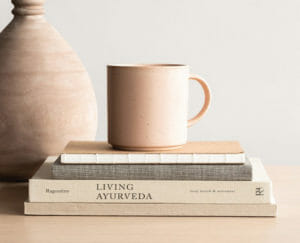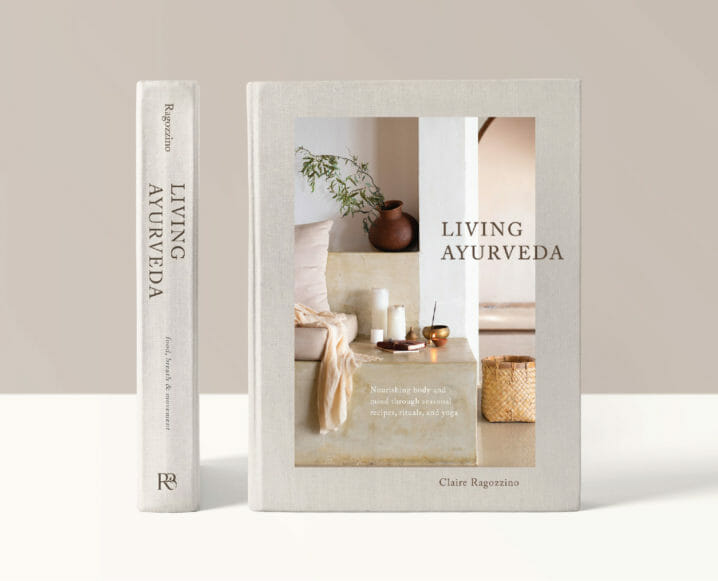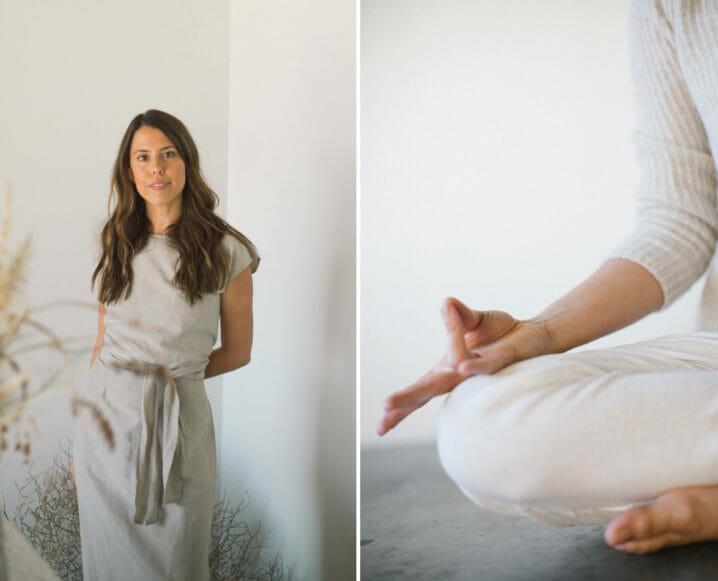
“Ayurveda is not a fad or a trend; it’s a time-tested science that applies to all cultures, places, and stages of life. If we slow down enough and learn how to listen, the answers to vibrant health can be found all around us."
"By paying attention each day to the signs of imbalance, you can make simple choices that encourage balance in your body and mind.”
This is the kind of simple wisdom we're learning from Claire Ragozzino in her new book, Living Ayurveda, a stunningly stylish wellness must-read that's part Ayurvedic cookbook and part lifestyle guide.
As with many great wellnessy hardbacks, Claire's book had us at 'hello' with cover art we needed on our coffee tables ASAP. Intrigued by both the depth of the content and the styling throughout, we decided to profile the author of Living Ayurveda here.
Claire is a certified yoga instructor and Ayurvedic counselor with a background in holistic nutrition and natural cooking. She is the author of the popular site, Vidya Living, and also writes and photographs for online and print publications surrounding topics of food, culture, and our relationship to nature.
Name: Claire Ragozzino of Vidya Living
Passion: My work is dedicated to bringing yoga, Ayurveda, and nutrition to a modern lifestyle. I wrote my new book for everyone looking to improve their diet and lifestyle with greater meaning and understanding of the WHY behind what they’re doing.
My new book: Living Ayurveda: Nourishing Body and Mind through Seasonal Recipes, Rituals, and Yoga is a hands-on holistic guide to self-care based on the ancient wisdom of Ayurveda. The book weaves together the teachings and practices of Ayurveda and Yoga in a modern, accessible way to provide a season-by-season guide for living a vibrantly rich year. Part cookbook, part lifestyle manual, each chapter includes simple vegetarian recipes, seasonal rituals, and self-care practices to cultivate your inner wisdom and feed your body, mind, and spirit.
The book in 3 words: food, breath, movement
Favorite recipes in the book? Spring Grain-Free Kitchari with Fresh Beet Salad, Summer Crispy Spiced Okra, Fall Warm Cinnamon Date Shake, and the Winter Vegetable Biryani. (Grab them all!)
Which tools are essential for those just starting with Ayurvedic cooking? My favorite kitchen tools are a microplane for grating things like ginger (I use this daily!), a mortar and pestle for grinding spices, and a pressure cooker—whether this is a traditional stovetop pot or the newer electric InstantPot—these are great for cooking beans and other dishes in half the time.
What usually compells those who are new to Ayurveda? If you’ve tried every diet under the sun, every superfood and supplement, and trendy workout class, but you still don’t feel your best—Ayurveda provides a deeper wisdom and timeless truth. Beyond fads, it empowers you with knowledge about yourself and how to care for your body, mind and spirit through the different seasons and cycles of life.
How would you describe the Ayurvedic diet? An Ayurvedic diet focuses on unprocessed, whole food ingredients, cooked with digestive supporting spices, and prepared and eaten with an attitude of love.
An Ayurvedic meal includes the six tastes—sweet, sour, salty, bitter, pungent and astringent—to nourish all the tissue layers of the body and promote satisfaction. Ayurvedic principles can be applied to any style of cuisine. While Ayurveda’s roots trace back to India, the concepts can be applied cross-culturally.
We use the knowledge of a food’s properties (whether it is heating or cooling, building or lightening), to create dishes with balanced tastes and desired effects. There is no one diet or menu plan that can fit everyone, as each person has a unique body type, digestive capacity, and needs, depending on their constitution, stage of life, and environment.
Eating seasonally is also an essential practice. As the seasons shift, we select foods and tastes that balance the dominant doshas. Therefore, this concept of food as medicine is the main approach to an Ayurvedic diet. We are always trying to use food intentionally to nurture balance within ourselves. Sometimes, this may include meat or other animal products. An Ayurvedic diet doesn’t exclusively mean a vegetarian diet, though many of the dishes incorporate plants as the foundational components (legumes, whole grains, nuts, seeds, fruits and vegetables) cooked in a variety of delightful ways.
Which Ayurvedic practices are most dear to you to keep immunity high? Eating without distraction. I know you wouldn’t think much of this at first, but immunity starts with how effectively we are digesting our food.
Our bodily tissues are formed by the food we take in. If we’re eating when we’re stressed, driving, or one of the many ways we multitask during our mealtimes, our food does not get properly digested. When this becomes our norm, over time our tissues become depleted and so does our immunity.
Ojas is one word for immunity in Ayurveda. The byproduct of strong digestion and good tissue formation is the production of ojas. So the simplest practice you can do to bolster your strength and boost your immunity, is to eat quietly and routinely. Meaning, 3 meals a day, around the same time, and without too much distraction. Skipping meals or grazing weakens your digestive fire. So keep your fire well fed! Not too much, not too little. You’ll be amazed how quickly this can improve how you feel!
We love your shop! What are your favorites from the curation?
For the foodie: InstantPot + Masala Dabba Spice Box + Stone Mortar & Pestle
For the yogi: Meditation Cushion Set + Manduka Yoga Mat + Myofascial Release Ball Kit
For self-care: Ionic Dry Brush + Beauty Balm + Copper Tongue Scraper
Oil pulling and tongue scraping we get, but talk to us about the ear oil you offer? Ah, ear oil! This is wonderful for calming Vata and a great ally for the fall/winter seasons, when Vata dosha is naturally elevated.
Vata Dosha is made of the air and space elements, which are mobile, cold, dry and rough. Ringing in the ears or tinnitus often comes from a drying of the inner ear, so we use warm oil to balance these cold, dry and rough qualities. Karna Purana is one the therapeutic practices for nourishing the ears by filling with warm oil. It is a soothing and calming treatment that can be done with a practitioner. It’s also used to reduce jaw pain and TMJ symptoms, relieve headaches, reduce vertigo, and prevent ear infections.
As a daily self-care practice, apply 1-2 drops of warm ear oil or untoasted sesame oil into your ear and rest with the head tilted to the side for 5 minutes while you let the oil absorb. Repeat on the other side. This is a great practice after traveling or if you’ve been out in windy, cold weather. If you have an active ear infection or perforated eardrum, you’ll want to skip this practice!
Any great tips for meditating at home now? Many of us are anxious this winter! We often think meditation means sitting in total stillness and transcending all our thoughts. This can feel near impossible in the busy world we live in! However, meditation can happen in many forms.
For a busy mind, my favorite meditation technique is a five sense meditation. With closed eyes, start first by listening, paying attention to your ears and what sounds you hear around you. Spend several moments tuning into sound. Then, shift your attention to touch. Notice the sensations on your skin, where your clothes meet your body, the subtle movement of air, the temperature and touch of your hands resting on your thighs. Next, with eyes closed still, notice your sense of sight. Observe shapes and colors behind the lids, notice what it feels like to rest your eyes and withdraw the stimulation of screens and other images. Move then to taste, feeling the tongue and paying close attention to the subtle tastes on the tongue. And last, connect with your sense of smell. Take a deep breath to observe all the aromas you breathe in. By paying attention to the senses, if even for just for a few minutes, we draw our awareness to one point of focus to calm an anxious mind.
Enjoy Claire's stunning and practical new book, Living Ayurveda: Nourishing Body and Mind through Seasonal Recipes, Rituals, and Yoga at home! Claire works with clients around the globe and leads immersive workshops and retreats. Join the Living Ayurveda Book Club to learn Ayurveda season-by-season.
This story is brought to you in partnership with Roost Books. From time to time, TCM editors choose to partner with brands we believe in to bring our readers special offers. The Chalkboard Mag and its materials are not intended to treat, diagnose, cure or prevent any disease. All material on The Chalkboard Mag is provided for educational purposes only. Always seek the advice of your physician or another qualified healthcare provider for any questions you have regarding a medical condition, and before undertaking any diet, exercise or other health-related programs.
The post At Home with Living Ayurveda’s Claire Ragozzino appeared first on The Chalkboard.
from The Chalkboard https://ift.tt/2JSSSqg
via IFTTT


No comments:
Post a Comment